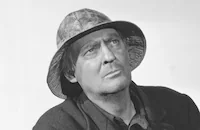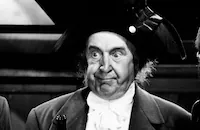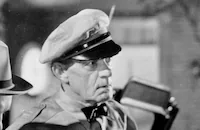The Voice of Bugle Ann

Brief Synopsis
Cast & Crew
Richard Thorpe
Lionel Barrymore
Maureen O'sullivan
Eric Linden
Dudley Digges
Spring Byington
Film Details
Technical Specs

Synopsis
In the Ozark Mountains of Missouri, local farmers participate in fox hunts with special dogs that they breed. Spring Davis, a local farmer, loves his dogs very much, especially "Molly," and when Molly dies giving birth to a litter of pups, the saddened Spring favors the runt of the litter, "Miss Ann." As Ann matures, she develops a rare "bugle voice" bark, so the proud Spring calls her "Bugle Ann." On the night of Ann's first hunt, she comports herself like a champion, pleasing Spring, but the evening is marred by the discovery that their mean-spirited neighbor, Jacob Terry, is erecting a fence on his property to raise sheep. Spring and Terry argue over the fence and, after Terry threatens to shoot any dog that comes on his property, Spring warns him that he will "blow him clean to glory" if he shoots a dog. Despite Spring and Terry's animosity, Spring's son Benjy and Terry's daughter Camden are in love. Though Spring recognizes that Camden is not like her father, Terry feels nothing but hatred toward Benjy and warns Camden not to see the boy again. That night, Terry hits Camden, and she packs up and drives away, leaving her father alone. Because Cal Royster, one of Spring's friends, hears a dog's yelp coming from Terry's farm and Ann has not returned home, the next day the Roysters, Spring and other local farmers arm themselves and go looking for her at Terry's farm. Spring finds a three-toed track in the dirt that could only have been made by Ann and angrily confronts Terry, who denies that he has harmed the dog. He then takes aim at Spring with his rifle, but before Terry can shoot, Spring shoots and kills him. Because neither Ann nor her body has been found, Spring is convicted of killing Terry and sentenced to twenty years in prison. Within a year, the sound of Ann's voice has been heard at night throughout the county, and many believe that it is the voice of a ghost. Two years later, however, Ann's body is found, strangled in a wire fence in the hills, and everyone realizes that Terry had not killed her after all. Another year passes, and Spring is suddenly pardoned by the governor and comes home to learn about Ann. On the night of his homecoming, Spring decides to go on a hunt and hears a bugle bark in the distance. Just then, Camden comes to his camp fire and says that the voice is that of a pup she has reared, the daughter of Ann and a champion dog called "Proctor Pride." She then reveals that she had accidentally hit Ann with her car on the night she ran away. She then cared for the dog, who had four pups, one of whom inherited Ann's bugle voice. Ann was eventually killed as she was chasing a fox running toward home. Camden also reveals that it was she who enabled Spring to be released by petitioning the governor. Finally, Camden and Benjy are free to start their life together and Spring looks forward to years of hunting with Ann's daughter, "Little Lady."

Director

Richard Thorpe
Cast

Lionel Barrymore

Maureen O'sullivan

Eric Linden

Dudley Digges

Spring Byington

Henry Wadsworth
William Newell
James Macklin

Jonathan Hale
Frederick Burton
James Marcus
Clayton Drew
William Moore
Guy Sar
Ben Hall
Sam Adams
George Guhl
Sidney Bracy

Lew Kelly
Burr Caruth
Louis Mason
Lillian Drew
Marie Layton
Frank Sheridan
Crew
George Boemler
John W. Considine Jr.
O. O. Dull
Harvey Gates
Cedric Gibbons
Ernest Haller
Samuel Hoffenstein
Joseph Kaestner
Rudolph Kopp
William Lynch
Al Raboch
Milan Roder
Heinz Roemheld
Stan Rogers
Douglas Shearer
Dolly Tree
Edwin B. Willis

Videos
Movie Clip



Trailer
Film Details
Technical Specs

Articles
The Voice of Bugle Ann
Filming only lasted a month, going from November 25 to December 30, 1935, with the hunting scenes shot in the Ozark Mountains and the exteriors with the stars and supporting cast shot in Burbank and in the San Fernando Valley, California. Before World War II, the Valley (as it is known in Los Angeles) was mostly farm land. Barrymore himself owned a house with property in the Northridge section of the Valley. After the war, when the veterans returned to a housing shortage, the farmland was quickly carved into housing tracts. Today, it is almost entirely concrete and freeways.
Lionel Barrymore (along with his brother John) was a great lover of dogs but he could not get the dog playing Bugle Ann to bark when needed. He thought that if he brought the dog out to his home and spent some time with her, she would become more comfortable around him. The dog's trainer, Carl Spitz, who would later train Terry the terrier, who played Toto in The Wizard of Oz (1939), agreed. According to James Kotsilibas-Davis, "The hound became attached to the chauffeur, Harry Hinkley, who fed her. She ignored the star and refused to "bugle" on cue. 'Has she bugled yet?' Lionel asked. 'Yes sir, she shore has,' replied Harry, 'Once under the piano and twice on the rug.'"
"While attempting to get some proper baying from the hound, the star suffered minor wounds. He appeared on set with three patches of court plaster on the fingers of his right hand. 'That's where one of the dogs nicked him,' Charley Grapewin explained. 'He gets things addled,' Lionel said of his colleague. 'It was just the other way around. I nicked the dog.' Any animosity between man and dog disappeared on camera. The hound bugled on cue, and the hard-fisted man of the soil rose to silver-tongued eloquence in the famous courtroom paean for his pet. With scraggy moustache, battered hat, patched overalls, and voice and eyes surpassingly expressing pain and pleasure, the actor etches another memorable portrait."
Although the dog managed to "bugle" on cue once she returned to the set, the resulting sound wasn't quite what the sound director Douglas Shearer (brother of actress Norma Shearer) wanted. He finally managed to get the right tone by mixing the dog's bark with a French horn.
The Voice of Bugle Ann was released on February 15, 1936 and was warmly received by the critics. Frank Nugent, in his New York Times review of the film, wrote, "Metro has adapted [Kantor's] story into the tender, sentimental and richly human photoplay of the same title that opened yesterday at the Center Theatre. Far removed from the usual grist from the Hollywood mills, the picture shines with a clear and beautiful simplicity and rings--if so gentle a piece can ring--with conviction...Out of it, more importantly, has come a picture that should be excellent entertainment for every lover of dogs and still should be entirely satisfactory to those who can take them or leave them alone."
Lionel Barrymore would revise his role for the Lux Radio Theater version of the story with Anne Shirley and Porter Hall in July 1936. MacKinlay Kantor would likewise revisit his characters; writing a sequel, The Daughter of Bugle Ann (1953) in which Little Lady, Bugle Ann's daughter, helps to reunite the romantic couple of the first book.
Producer: John W. Considine, Jr.
Director: Richard Thorpe
Screenplay: Harvey Gates, Samuel Hoffenstein (writers); MacKinlay Kantor (novel)
Cinematography: Ernest Haller
Art Direction: Cedric Gibbons
Music: Rudolph Kopp; Milan Roder, Heinz Roemheld (uncredited)
Film Editing: George Boemler
Cast: Lionel Barrymore (Springfield 'Spring' Davis), Maureen O'Sullivan (Camden Terry), Eric Linden (Benjy Davis), Dudley Digges (Jacob Terry), Spring Byington (Ma Davis), Charley Grapewin (Cal Royster), Henry Wadsworth (Bake Royster), William Newell (Mr. Tanner), James Macklin (Delvin 'Del' Royster), Jonathan Hale (District Attorney).
BW-72m. Closed Captioning.
by Lorraine LoBianco
SOURCES:
Eyman, Scott Lion: The Life and Legend of Louis B. Mayer
Jacob, Merle, and Apple, Hope To Be Continued: An Annotated Guide to Sequels
The Internet Movie Database
Kotsilibas-Davis, James The Barrymores: The Royal Family of Hollywood
Nugent, Frank S., "Fox-Hunting Complications in Missouri, as Noted in 'The Voice of Bugle Ann,' at the Center", New York Times 27 Feb 36

The Voice of Bugle Ann
Quotes
Trivia
Notes
MacKinlay Kantor wrote a sequel to his novel, entitled The Daughter of Bugle Ann, in 1953. According to Hollywood Reporter news items, James Stewart was originally cast in the part taken over by Eric Linden. Portions of the picture were shot on location in the San Fernando Valley and Burbank, California, and background shots, including the hunts, were shot on location in the Ozark Mountains in Missouri under Richard Thorpe's direction. An early production chart in Hollywood Reporter included Claude Gillingwater in the film, however, he was not in the viewed print and May have been replaced during the filming. Lionel Barrymore and Anne Shirley starred in a Lux Radio Theatre version of the story on July 6, 1936. The type of fox hunting shown in the film was, according to reviews, indigenous to Missouri. In the Missouri hunts recreated, dogs chase the fox until he runs up a tree, then retreat when the hunt master blows his horn: the fox is neither killed nor injured.















